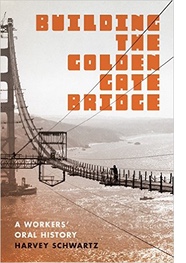Review of Harvey Schwartz’s “Building the Golden Gate Bridge: A Workers’ Oral History”
 The
Golden Gate Bridge, which opened for traffic in May 1937 took just
over four years to build. Now, 78 years later and for the first
time, the men (they were all men) who assembled that iconic structure
are being properly acknowledged for their heroic labors in Building
the Golden Gate Bridge.
The author, historian Harvey Schwartz is well known for his labor
history scholarship, most recently Solidarity
Stories, an
oral history of West Coast dockworkers. In 1987, in connection with
the bridge’s Fiftieth Anniversary, he interviewed a number of its
builders and their edited oral history narratives, along with
dramatic photographs taken during the construction project, make up
this new volume.
The
Golden Gate Bridge, which opened for traffic in May 1937 took just
over four years to build. Now, 78 years later and for the first
time, the men (they were all men) who assembled that iconic structure
are being properly acknowledged for their heroic labors in Building
the Golden Gate Bridge.
The author, historian Harvey Schwartz is well known for his labor
history scholarship, most recently Solidarity
Stories, an
oral history of West Coast dockworkers. In 1987, in connection with
the bridge’s Fiftieth Anniversary, he interviewed a number of its
builders and their edited oral history narratives, along with
dramatic photographs taken during the construction project, make up
this new volume.
The book is a beautifully-produced tribute to the unknown and unsung iron workers, cable spinners, electricians and laborers whose efforts literally put one of America’s most photographed and visited landmarks on the map. Schwartz begins with an introduction that provides a capsule history of the bridge. This is followed by chapters devoted to each of eight builders and two maintenance workers whose experiences are included, along with those of two nurses who cared for hospitalized workers injured on the job. An excellent set of endnotes filled with informative details on technical terminology and a “suggested further reading” section close the volume.
In addition to its value in providing us access to the stories of these workers, Building the Golden Gate Bridge makes important moral points. It is a timely reminder of how the United States has benefitted immensely by the talent of newcomers. Five of the eight men and one of the two nurses were the children of immigrants. The testimony of these workers reminds us of a time when the United States, even during its Great Depression, was a place that provided opportunities to ambitious young men and women willing to work. They took pride in their ability to do hard physical labor and thereby contribute to the improvement of the environment. A consistent theme in these workers’ stories is their certainty that they were not only making a living during hard times, but they were also contributing to their families and their country and thereby earning a stake in its future for themselves, their children, and their grandchildren.
This excellent volume is an indispensable addition to the literature on the building of the Golden Gate Bridge, as well as a “must read” for those interested in American social history and the labor history of the American West.